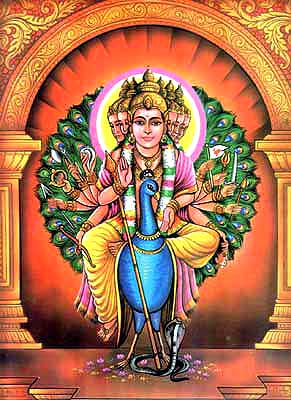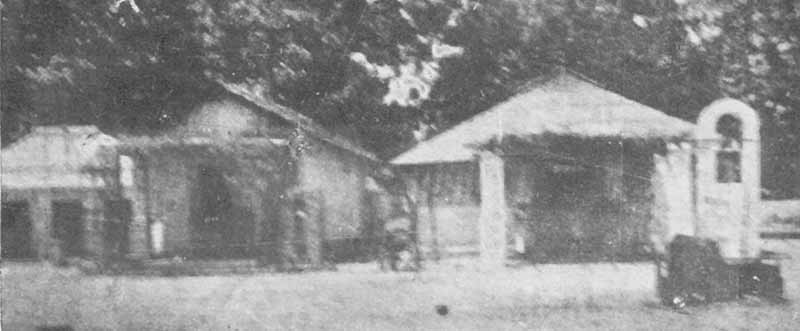|
| |||||
 Katirkamam: Lord Skanda's Abode
By Dr. (Mrs.) Vimala Krishnapillai
|

|
|
Kataragama kovils in 1950
|
Today from many points of Sri Lanka thousands visit Katirkamam by motor vehicle. It was not so in the days of old. Pada Yatra -- treading on foot, through the woody glades infested with dangerous wild animals and snakes was the only way to reach the sacred spot. Theirs was a true pilgrimage, an earnest quest, a voyage of self-discovery. The pilgrimage was a turning point in their life. Unless the call came from within, they did not dare on such an arduous pilgrimage. At the bidding of Lord Murukan, listening to His call, however faint it might have been, they set forth on the pada yatra. Even to this day there are a few who still follow this traditional form of pilgrimage to Katirkamam.
As far as Hindus are concerned, the history of Katirkamam goes back to centuries and its legends to millennia. The three important aspects of a place of worship -- murti, sthalam and teertham -- are there well set by nature. Murukan is the Katirkama Murti, the sthalam is the sacred land of Katirkamam where stands Katiramalai, the holy teertham is the river Manika Gangai. According to Dakshina Kailaya Manmiyam, from puranic ages Katiramalai was worshipped by the Hindus. There was the beautiful city of Jotish Kama Giri -- mountain of light and love, in which the celestial architect Visvakarma built a temple named Cintamani Alayam. Cintamani is a rare gem of intense luminosity which is said to fulfill all the desires of man. In Katirkama Puranam there is a verse which says that the mountain of Katiramalai, all lit up by sun, moon and Agni in the form of Katirjoti, fulfils kama, the desires of the worshippers. The traditional and popular belief of the Hindus is that Murukan manifests himself to his devotees taking suitable forms to fulfil their needs and leads them to salvation.
In the main devalaya there are two apartments, the adiyantra, which is the innermost apartment which is accessed through seven veils or curtains. In this adiyantra is a casket believed to contain a yantra, a mystic diagram embossed on a golden tablet studded with gems, which possess divine power and grace. During festivals the casket is borne on a decorated elephant and taken in procession to the Valli Amman temple and after puja there it is brought back to the original place. The seven veils symbolize the seven obstructions which are to be overcome by the soul to reach the supreme reality. Valli, the beloved consort of Murukan, symbolizes Iccha Sakti, the energy of desire of the human soul -- jiva atma, which yearns to reach the Paramatma or God.
Katirkama Murti is a god to all irrespective of caste or creed or one's status. He manifests himself where ever and whenever sought with love and devotion. He accepts all forms of worship both anpu vali puja (love or folk form of worship) as well as the agamic rituals.
Among the time tested and proven paths to earn His grace are these spontaneous indigenous forms of worship. Around the devalaya pilgrims circumambulate with mouths gagged, silver headed pins piercing their lips or cheeks. With hooks pierced in their backs, votaries hang from a beam. Such acts of mortification of the flesh and infliction of physical pain for atonement and reparation from sins and for the purpose of acquiring merit for spiritual salvation are common sights there; fire walking the expurgatory ritual of purifying by walking over red hot cinders; carrying the clay pots of burming camphor on their heads in fulfillment of simple vows. Kavadi dance and music are common modes of worship.
After taking a dip in the cool waters of Manicka Ganga early in the morning, the pilgrims proceed to climb Katiramalai with 'Haro Hara' on their lips and the thought of Murukan in their hearts and on their return they perform pradakshina round the shrine. Unexplainable psychological states or dimensions such as trance visions and possessions may also be observed there. Simple vows made in the privacy of their hearts and their fulfillment by puja and allied practices attracts millions of worshippers there. Feeding the needy and the devotees here annadanan (the sharing of food and good fortune) benefits both the giver and receiver.
All acts of penance and worship involves the sacrifice and surrender of something smaller, in exchange for something greater by which the abundant grace of the Lord of Katirkamam is received.
A true pilgrim walks alone even in company. "Oh pilgrim! Listen to the call however faint it may be, and if none comes along to join you, walk alone". In the inner pilgrimage of the soul, this has both an earthly and esoteric meaning.
This article by Dr. (Mrs.) Vimala Krishnapillai first appeared in Hindu Voice of May-June 1993. Contact Dr. Krishnapillai by e-mail at: vimalakrishnapillai@yahoo.com.
|